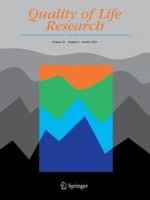01-10-2013
Factor structure of the Child Health Questionnaire Parent Form-50 and predictors of health-related quality of life in children with epilepsy
Gepubliceerd in: Quality of Life Research | Uitgave 8/2013
Log in om toegang te krijgenAbstract
Purpose
The present study investigated the higher-order summary factor structure of the Child Health Questionnaire Parent Form-50 (CHQ) in a sample of children with new-onset epilepsy. The secondary aim was to identify risk factors predicting health-related quality of life (HRQL) 24 months post-diagnosis.
Methods
Data came from the Health-related Quality of Life in Children with Epilepsy Study (HERQULES, N = 374), a multi-site study documenting HRQL among children with epilepsy from diagnosis through 24 months. Confirmatory factor analysis was used to determine goodness of fit between the original structure of the CHQ and HERQULES data. Multiple regression was used to identify risk factors at diagnosis for HRQL at 24 months.
Results
The models demonstrated good fit: baseline: CFI = 0.945; TLI = 0.941; WRMR = 1.461; RMSEA = 0.058; 24 months: CFI = 0.957; TLI = 0.954; WRMR = 1.393; RMSEA = 0.055. Factor loadings were high and no cross-loadings observed (first order: λ = 0.27–0.99, 0.24–0.98; second order: λ = 0.69–0.86, 0.54–0.92; p < 0.001 for all). Controlling for HRQL at diagnosis, predictors for better 24-month HRQL were as follows: physical health: fewer cognitive problems (p = 0.023) and parents with fewer depressive symptoms (p = 0.049); psychosocial health: older parent age (p = 0.043), fewer behavior problems (p = 0.004), and families with better functioning (p = 0.008) and fewer demands (p = 0.009).
Conclusions
The CHQ higher-order summary factor structure was replicated in a sample of children with new-onset epilepsy, and child and family risk factors at diagnosis were found to predict HRQL 24 months post-diagnosis. These findings suggest it is possible to identify at-risk children early in the illness process and provide impetus for adopting family-centered care practices.
